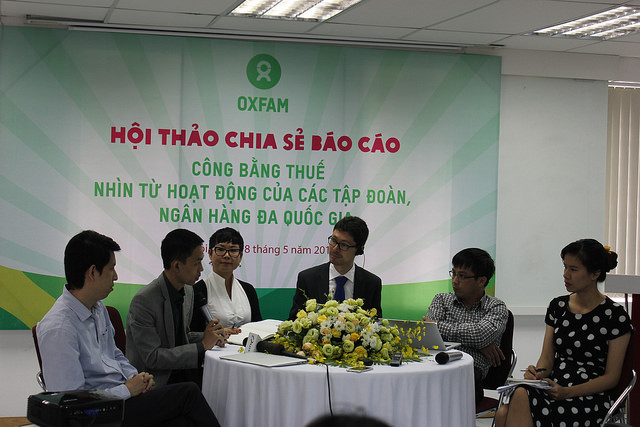Vietnamese tax incentive system woefully inadequate
 |
| RELATED CONTENTS: | |
| New decree to thwart BEPS practices | |
| New transfer pricing decree: a step closer to international standards | |
| Tax reform and transfer pricing | |
Oxfam made the assessment today at the event titled “Tax equality: a view from the operation of multinational companies and banks.” The event aims to introduce the three latest reports produced by Oxfam on the use of tax havens by Europe’s biggest banks, the “rigged” tax reform proposed by the new US administration, and the global race to offer the lowest corporate tax, respectively, and assess Vietnam’s tax incentive policies.
Oxfam’s research shows that developing countries including Vietnam have been losing $100 billion annually as a result of corporate tax avoidance schemes.
Recently, the government issued Decree No.20/2017/ND-CP regulating tax administration with respect to enterprises having transactions with related parties. Starting May 1, large companies are required to provide country-by-country reporting.
According to Francis Weyzig, policy advisor on tax justice and economic inequality at Oxfam Novib, this requirement makes the Vietnamese tax system more advanced than those of the OECD. However, Vietnam can consider having public country-by-country reporting.
“The European Union’s public reporting requirements have shown benefits. If data is available publicly, it allows investors and the public to assess a company’s tax behaviour. It stimulates less aggressive tax behaviour. It enables monitoring of profit shifting developments, provides information about tax incentives, and helps to hold governments accountable,” he said.
In Vietnam, tax incentives take the form of reduced tax rates, tax holidays, investment allowances, tax credit, partial or full exemption from import tax or indirect taxes, accelerated depreciation, and incentives provided in economic zones and export processing zones.
According to Oxfam’s evaluation, the tax incentives are generous and scattered. They are generous in the sense that the corporate income tax in Vietnam is now lower than the regional average, as the country has reduced its rates from 28 to 20 per cent, and at the same time, it gives more incentives than Thailand, Malaysia or Indonesia.
As of 2014, Indonesia gave Samsung tax exemption for 10 years, while Vietnam gave 15 years. Many countries have abolished tax incentives, such as Jamaica, Egypt, and China, which only offers tax reductions for high-tech companies.
At the same time, tax incentives are scattered among sectors, areas, and situations, with 30 encouraged sectors, 27 specially encouraged sectors, 53 out of 63 provinces, and over 300 economic, high-tech, and export processing zones as well as tax rulings. Regulations regarding tax are also scattered in different legal documents issued by multiple ministries. This, according to Oxfam, creates loopholes for tax avoidance.
Oxfam assessed that many incentives are not effective. For example, incentives based on the company’s profit, such as holidays and reduction, cause companies to change their investment projects after holidays in order to qualify for a new holiday. Location-based and sector-based tax incentives still fail to attract more investment into the regions and sectors that they are intended to help.
There is no information on which and what level of incentives companies are enjoying. Government agencies and local authorities rarely publicise information on budgetary loss from tax incentives, and they do not include tax incentives in calculating budget expenditure. There is no thorough analysis on the costs and benefits of tax incentive policies in terms of encouraging investments.
According to Oxfam, expanding tax incentives is one of the reasons for a reduction in state budget revenue.
Oxfam recommends that Vietnam establish a mechanism to collect information on tax incentives, which includes the number of qualifying projects, the economic contribution of these projects, and the budget loss from tax incentives, and then make this information public.
There should also be a cost-benefit analysis before and after implementing tax incentives. The government should also review and gather all incentive policies to avoid redundancy, and limit the use of tax holidays and reduced tax rates which have the highest cost in terms of budgetary revenue.
Dau Anh Tuan - Director general of the Vietnam Chamber of Commerce and Industry's Legal Department
 |
In a 2013 survey of foreign-invested enterprises (FIEs) on transfer pricing, VCCI found that companies, no matter where they come from, are no different in their stance on transfer pricing. In Vietnam, many big multinational companies (MNCs) continuously report losses, but keep expanding and recruiting. They also keep praising Vietnam as an investment destination. Many FIEs said that Vietnam’s tax policies are not stable, which is why they have to hedge risks by transfer pricing in order to ensure that their investments are effective. I propose that the related government agencies look into this.
Moreover, there are differences in the treatment of FIEs and domestic companies. Many localities have the mindset that attracting FIEs is equivalent to success. So FIEs house with their projects from province to province, shopping for the most incentives on offer. There should be a report on the effect of FIEs on provinces.
Nguyen Duc Thanh - President of the Vietnam Institute for Economic and Policy Research
 |
Transfer pricing is a global issue. Oxfam’s reports are going to alert policy makers of all countries, developed or developing, prompting them to cooperate to bring tax dodging activities of big companies under control.
FIEs currently contribute 72 per cent to Vietnam’s exports, while the domestic private sector and state-owned companies contribute the rest. Of this 72 per cent, big companies like Samsung contribute the most. The Vietnamese government encourages these companies to invest, hoping that their investments are going to create a ripple effect, bringing growth for Vietnamese companies, too.
However, these big MNCs are the most likely to do transfer pricing, because they have bases everywhere. If Vietnam continues to give them incentives and grow dependant on them, tax-related risks will only mount. When Vietnam integrates deeper into the global economy, it should work with international organisations to improve its tax system to prevent such risks.
Phan Le Thanh Long - Regional director of Certified Management Accountants (CMA) Australia in Vietnam
 |
Foreign companies that earn big profits in Vietnam have very high motivation to conduct transfer pricing. There are two ways they go about this. Output-wise, they take advantage of the different tax rates between companies and between different localities in Vietnam. Input-wise, they inflate the price tag on the equipment they import into Vietnam or the cost of installation and consultancy and management fees from the parent company.
Vietnam issued Circular 66 on providing guidelines on calculations of market price in business transactions between affiliated parties in 2010, but it proved ineffective in preventing transfer pricing. The new Decree 20 is an upgrade. It applies to all transactions of all companies, not just FIEs or Vietnamese companies.
However, many companies that have been operating stably in Vietnam and have been very good at complying with tax regulations are concerned that the additional reporting requirement is going to be a burden.
What the stars mean:
★ Poor ★ ★ Promising ★★★ Good ★★★★ Very good ★★★★★ Exceptional
Latest News
More News
- F88 partners with MB to transform over 850 financial stores into bank offices (December 17, 2024 | 18:04)
- Obstacles to stock-market upgrade to be removed (December 17, 2024 | 11:29)
- Vietnam seizes opportunities amid global trade shifts (December 16, 2024 | 18:00)
- Long-term perspective remains optimal approach (December 16, 2024 | 14:26)
- Fiscal measures to be based on upcoming US status (December 16, 2024 | 10:09)
- PetroVietnam accelerates divestment from PVI (December 16, 2024 | 06:59)
- Techcombank proactive with ESG and sustainability (December 14, 2024 | 10:00)
- VAT cut set to continue on through to summer (December 14, 2024 | 09:00)
- BIWASE Long An issues Vietnam's first AAA-rated bonds worth $27.6 million (December 13, 2024 | 20:22)
- Citi hosts Vietnam Day for Hong Kong clients (December 13, 2024 | 14:21)


















 Mobile Version
Mobile Version